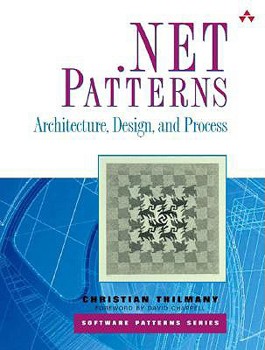.Net Patterns: Architecture, Design, and Process
(Part of the Software Patterns Series Series)
bull; bull;Extends the proven concept of design patterns to the relatively new field of .NET design and development bull;Part of the acclaimed Addison-Wesley Software Patterns Series, with John... This description may be from another edition of this product.
Format:Paperback
Language:English
ISBN:0321130022
ISBN13:9780321130020
Release Date:January 2003
Publisher:Addison-Wesley Professional
Length:448 Pages
Weight:2.05 lbs.
Dimensions:0.9" x 7.0" x 9.3"
Related Subjects
Computer Science Computers Computers & Technology Database Design Databases Design Tools & Techniques Object-Oriented Design Object-Oriented Software Design Programming Languages Software Design & Engineering Software Design, Testing & Engineering Software Development Software EngineeringCustomer Reviews
4 ratings
A well wrote book
Published by Thriftbooks.com User , 15 years ago
A very practical code book for everyone. The writer seems to hit all areas of being practical and yet pointing out patterns that can be used in a person's life everyday. I would definitely recommend this book to other people in the same field. I just happened to come across this not that long ago, while searching the internet. I am only hoping that the writer does another book and would be interested to see what he applies next.
Practial Book on .NET Patterns
Published by Thriftbooks.com User , 19 years ago
I really don't understand the bad ratings of other reviewers. Either these reviewers didn't read the book or they are totally in love with theoretical issues on design patterns. This book shows hand on experiences - the authors shows REAL WORLD examples and illustrates how patterns are applied. I found the book very useful and it contains new interesting ideas on implementing PRACTICAL and USEFUL software applications with the .NET framework.
A book for the working designer
Published by Thriftbooks.com User , 20 years ago
Finally a practical design book -- with code. Very unique. At last, a book for both architects, and developers of .NET. Thilmany really speaks to level that is practical and backs up the rhetoric with architecture patterns that can actually be used in REAL LIFE! This book employs the whole think-like-a-fundamentalist-but-design-like-a-technician strategy, revealing how to devise critical, complex designs for use in the real world. This is something I'm going to recommend to my team (all 15 of us) and hope we get a second edition soon. This book fills in the gaps where the trade publications leave off. Best...bucks I've spent yet on .NET so far.
Great pattern resource, cool approach; U can skip the intro
Published by Thriftbooks.com User , 20 years ago
First, I've not got what would be considered by academic circles as a classical computer science background. I majored in marketing in college, and learned the art of programming and software design out of necessity for my Web projects to work. Needless to say, I've not had a solid background, and thus an appreciation for or acknowledgement of, design patterns within the scope of developing great software.This book has changed all that. This work is written in author Christian Thilmany's honest perspective and admission that much of the design of Microsoft's ambitious .NET initiative was to take from the things that made Java such a great developmental platform and allowed it become "the language of the Internet". And this rare viewpoint is well appreciated. Being a solutions developer well versed in both Java and Microsoft platforms, this honesty lends credibility to the claim of showing how much of .NET can be attributed to roots in Java, which other authors either bash for the sake of bashing any opponent of the good folks in Redmond, don't give enough credit to, or shy away from completely. I've always seen this as unfair to the reader. Using the approach to explaining and providing design patterns based on the similar structures used in Java programming, Thilmany shows how utilities can be assembled for use for all three major tiers of a development project. Since much of the work of design patterns is used in Java anyway, he has no reservations about explaining how work in similar fashion with .NET. And the reader is better off for it. It's not only the code-based patterns themselves which are great, but also the method in which the author presents getting to the patterns, being examples that are repetitive, consistent, sequential and iterative, allowing the reader to condition their mind in an efficient problem-solving sequence of events: (Intent ==> Problem ==> Forces ==> Structure ==> Consequences ==> Implementation). So, it's the mental pattern of solutions development that's also discussed, and I feel, the greatest advantage to this book. <br><br><p>The book is also effective, I've found, for Web application architects. Typically, Web devs and those from the ilk of an ASP 3.0 background tend to shy away from topics like patterns, remoting and DCOM, as it largely was a topic rarely, if ever to be used in their work. Thilmany gives lots of helpful tips and hints in pattern design and architecture, with relevance for the Web crowd, as well as the desktop developer. <br><br><p>Now, being critical, I found the book's first part, in giving a primer on .NET in general and for the XML Web services model, a bit extraneous, or at least not excessive enough to warrant three full chapters. But the book from there on is gold. The patterns themselves are plentiful, well-explained and the book is beautifully written. <br><br><p>And you'll be a better overall developer for checking it out.





